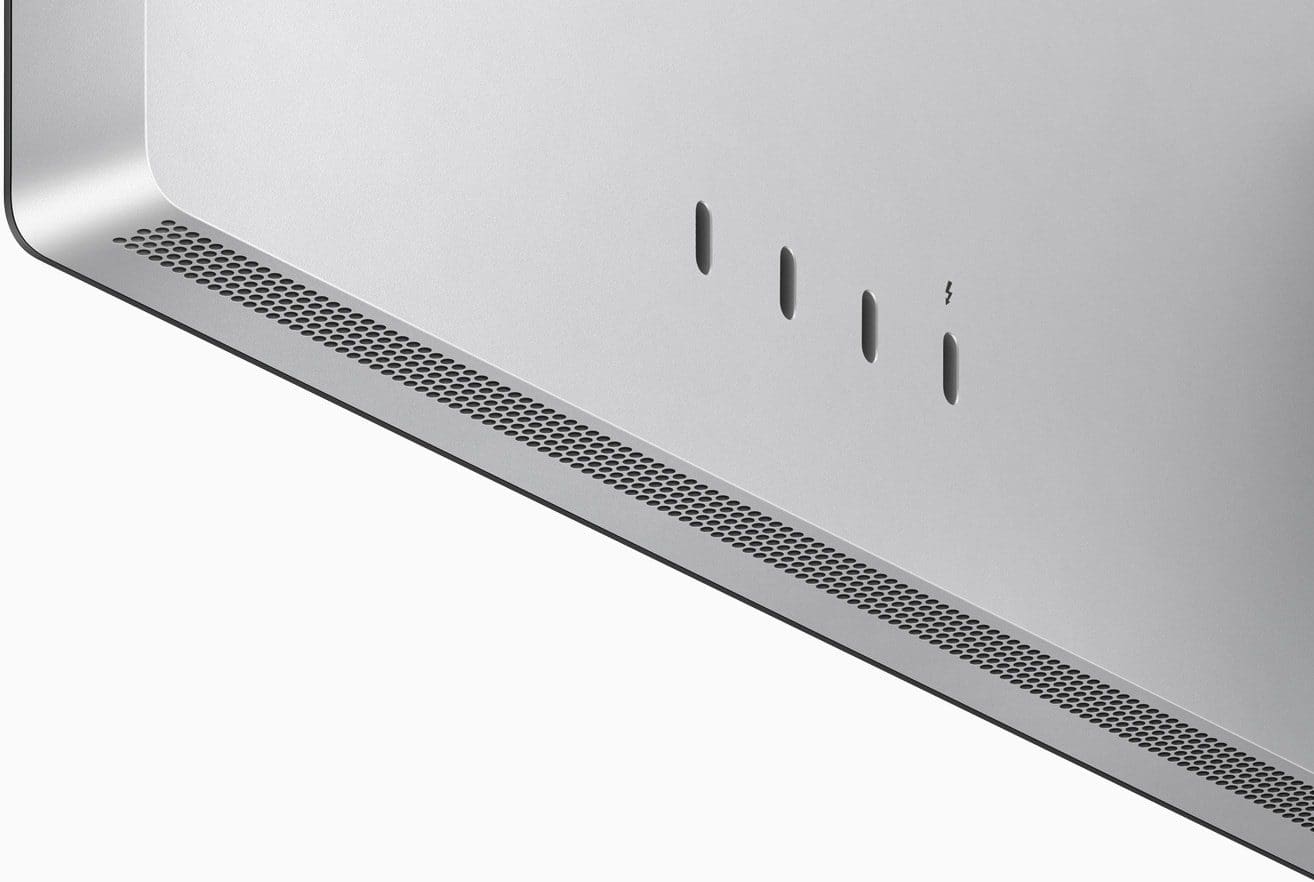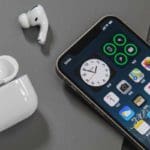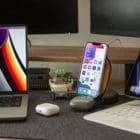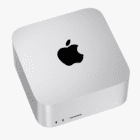The Apple Studio Display is the tech giant’s newest standalone 27-inch monitor. It offers a high-resolution 5K LCD Retina display with a speaker system, microphone array, and a built-in camera in a thin aluminum design.
This latest addition to Apple’s display options starts at $1599 and was released alongside the $1999 Mac Studio.
It is the newest external display in Apple’s offers and there are no previous models.
In this review, we’ll look at all there is to know about the Studio Display and if it comes out as the best monitor for your MAC.
Contents
- Apple Studio Display Review: Overview
- Apple Studio Display Review: Design Features
- Apple Studio Display Review: Speaker Features
- Apple Studio Display Review: Screen
- Apple Studio Display Review: Interface Features
- Apple Studio Display Review: Webcam Features
- Apple Studio Display Review: Price
- Apple Studio Display Review: Pros and Cons
- Final Thoughts
Apple Studio Display Review: Overview

The Apple Studio Display was launched in March 2022 and is the first monitor from Apple since the 2019 Pro Display XDR. It is also the first low-cost display option after the Thunderbolt Display in 2016 was discontinued.
Concerning pricing, it starts at $1599.
The studio display features a 27 inch 5K Retina display alongside a resolution of 5120 by 2880. This is at 218 pixels per inch. Ironically, this is the same resolution as the discontinued 27-inch iMac.
The Studio Display supports up to 600 nits brightness. This means it is not as bright as the Pro Display XDR. It provides True Tone to ensure that the white balance of the display matches the lightning in your room and P3 Wide Color for true to life, vivid colors.
Additional Details
This monitor is built with glass that offers very low reflectivity and there is a $300 upgrade that can get you Nano-texture glass that minimizes glare in environments with bright lighting.
With regards to design, the Apple Studio Display comes with slim black bezels all around, as well as, an iMac style aluminum stand, alongside 30 degrees of adjustable tilt (-5 degrees to +25 degrees). The stand is factored in the pricing of the display.

Built-in Stand
However, for an additional $400 you can get a tilt and height-adjustable stand that provides the same tilt ability but 105mm height adjustability. And a VESA mount adapter that allows the display to be utilized in landscape or portrait orientation.
This monitor measures 24.5 inches wide, 6.6 inches deep, and 18.8 inches tall. It also weighs 13.9 pounds. The height and tail built-in stands put some additional pounds and some more depth and height. However, the VESA mount version is shorter and lighter in weight due to the lack of an included stand.
The back of the display features a single Thunderbolt 3 Port that caters to 96E charging. This is adequate for charging any Apple laptop. It also has 3 extra 10GB/s USB-C ports that help to connect peripherals. The display connects to your Mac via 1 Thunderbolt cable which comes with the package.
How Does the Apple Studio Display Compare with the Pro Display XDR?
In comparison to the Pro Display XDR, the 2022 Studio Display stands out as it features a built-in A13 Bionic chip that powers the audio and camera systems. It also comes with a 12-megapixel f/2.4 ultra-wide camera that is capable of a 122-degree field of view.
This ultra-wide camera also enables the Center Stage function. This is a feature that allows a camera to keep you centered in the frame when you move around while face-timing.
The A13 bionic facilitates Spatial Audio to give a cinematic sound as well as offers a built-in Hey Siri feature. This gives the Siri functionality to desktop Macs that do not typically offer the capability. The A13 Bionic also powers a high-fidelity 6-speaker sound system. The speaker system is powered by 2 high-performance tweeters and 4 force canceling woofers. There is also a 3 microphone array that comes with the speakers for top-notch audio.
Studio Display Compatibility
Concerning compatibility, the Apple Studio Display is compatible with Mac studio 2016 and previous MacBook Pro models, 2017 and previous iMac models, 2018 and previous Mac mini models, 2018 and previous Mac Air models, 2019 and previous Mac Pro models.
This latest display also works with the fifth generation iPad Air, 11-inch iPad Pro models, and the third generation and previous models of the 12.9-inch iPad Pro. If connected to the iPad mini 6 or iPad Air fourth generation, the display operates at a lower 1440p resolution.
That said, it isn’t all good news for the Apple Studio Display.
For one, if you don’t plug it into a compatible iPad or Mac the monitor loses a huge chunk of its value. You also cannot update it without connecting a Mac to download the relevant firmware. And if you manage to get it working with a Windows PC the Studio Display will simply be a costly 5K external display with built-in speakers and a camera.
The cons aside, the Studio Display is arguably one of the best monitors for the MacBook Pro. So if you use the Pro you’d want to consider using the display.
Apple Studio Display Review: Design Features
There are very few monitors available on the market that offer features such as a 6-speaker sound system, a built-in 12MP ultra-wide camera, an A13 Bionic chip, and a triple-mic array.
Apple managed to pack all of this into the professional-looking and sleek body featuring a 5k 27-inch screen surrounded by a dark bezel just more than half an inch thick.
The Studio Display camera is fitted at the center of the top bezel, however, it does not feature a physical privacy shutter. It also has 6 speakers (2 tweeters and 4 force-canceling woofers) built into the display capable of producing Spatial Audio. And 3 microphones.
Apple states that the microphones are studio-quality and are powerful enough to record professional music.
At the back of the Studio Display, you’ll see a permanently attached power cable that is routed via a cut-out in the stand. By the lower left side (if you look at it from the back) you will see 3 USB-C ports, as well as, a single Thunderbolt 3 Port.

You can use this to connect the Studio Display to a compatible iPad or MacBook. It gives out power as well, so you can plug your iPad or MacBook into it to charge it while in use.
Apple Studio Display Review: Speaker Features
Though it may seem odd to have an entire section of the Apple Studio Display review focus on sound quality, this monitor is a unique one.
It has a 6-speaker sound system embedded into it that produces quality sounds like very clear vocals and heavy bass. If you are a lover of music the Apple Studio Display speakers can easily become the best sound system in your home.
The Studio Display speaker even supports Spatial Audio via Dolby Atmos. This means that supported videos and audio will sound like they are surrounding you and not just coming from a monitor. The Spatial Audio tech used in the Studio Display is currently utilized by Apple on a range of devices. This is a huge feature considering that Apple Music provides a great selection of tracks that offer Spatial Audio features.
It is an excellent function that makes the audio produced more immersive. That said, with this monitor, it doesn’t sound like it’s around you. Rather, the Spatial Audio feature sounds like it’s originating from about 5 to 6 inches in front of the Studio display, not directly from it. The idea is basically that the sound projects more and feels more impactful and deeper.
So actually replicating a 360° sound is something we would want to expect from newer models of the Apple Studio Display.
Apple Studio Display Review: Screen

Images don’t do justice to the beauty of the 27-inch 5K (5120 × 2880 pixels) screen of the Studio Display. It displays more than 14.7 million pixels at a density of 218 pixels per inch.
The monitor’s display supports the P3 Wide Color gamut as well. It also comes pre-configured with various reference modes that allow creatives to switch between them based on the demands of a project.
The various reference modes adjust settings such as gamma, color space, and white point. However, unless you know what you are doing or have a good reason to play around with them you should leave it on the default setting.
That said, the Apple Studio Display lacks support for the HDR video reference mode and this makes sense because the display is unable to show HDR or high dynamic range content.
The Numbers
The Studio Display is also unable to match the 120hz ProMotion adaptive refresh rate, which is an available feature on most other Apple products. This is inclusive of the iPad Pros and 2021 MacBook Pros.
This is a huge letdown because you get used to the quick and smooth scrolling that happens because of a quicker refresh rate. Plus, if you intend to display over 60 frames per second (if you edit high FPS footage or play high-intensity games), this won’t be possible on the Apple Studio Display.
In the monitor’s default reference mode, which is P3-600 nits, it delivers 80.8% of the DCI-P3 gamut at a Delta-E score of 0.21 (the closer the number is to 0 the better) and 114.1% of the sRGB color gamut.
If you have no clue what the numbers mean, they only matter for professionals who intend to do detailed editing tasks that require color accuracy. For regular users, the scores show that the Studio Display is quite accurate with regard to the sRGB color space. However, it is not yet 100% capable of correctly displaying all colors in the broad DCI P3 gamut. For the Delta-E score, a low score is great because this means that there is little to no color distortion.
Brightness
Concerning brightness, the Apple Studio Display has an average maximum brightness of 518.4 nits. It peaks at 563 nits in the middle of the screen. This is very close to the tech giant’s promise that the Studio Display is able to hit up to 600 nits of brightness. It is also brighter than the regular max brightness you’ll find on Apple’s Pro Display XDR (467 nits) when you aren’t watching HDR content. The Pro Display HDR can show HDR and does get a bit brighter with the right conditions. But the 2022 Apple Studio Display cannot since it does not support HDR.
But it does get bright enough to use in sunlight if you increase the brightness to the maximum. The colors look perfect and pop when you amplify the brightness.
Also, if you are a gamer, most games look perfect in 5K with the Apple Studio Display. All in all, the visual quality is great.
Apple Studio Display Review: Interface Features
The Apple Studio Display has no interface and is basically unusable if there is no device to drive it. It also needs a Mac to update the firmware.
It is usually great to know how usable and useful your monitor’s interface is. However, the Apple Studio Display is void of one. There is no physical interface whatsoever 0 knobs or buttons, literally no switch to turn it on.
After connecting it to an outlet you would usually see it flicker on briefly and then show a “…” icon on the screen as it looks for connected devices. But without doing so it will stay dormant.
So there is only one way to interface with the Apple Studio Display and that is to plug it into a compatible device and turn it on. After doing this, the Studio Display will power on as well.
It is important to state that the device doesn’t have to be from Apple. For example, you can plug a Gaming Asus ROG Zephyrus G15 laptop into the Apple studio Display using the USB-C Port to use the monitor as a secondary display with few issues.
That said, Apple states the monitor has to be connected to a Mac to download and install firmware updates.
Apple Studio Display Review: Webcam Features
The monitor features a 12mp ultra-wide camera embedded into the top bezel. And the quality of both video and images it captures is as good as It gets.
In essence, the webcam built into the Apple studio display 2022 is an iPad camera. In fact, it is the same camera in the newly-released iPad Air 5 2022.
Just like all contemporary iPads, the Apple Studio Display features the Center Stage function. This feature intelligently zooms and crops the camera during video calls to ensure that you stay in the frame when you move around.
The Apple Studio Display is able to achieve this due to its ultra-wide camera and inbuilt A13 bionic chip, which is responsible for the necessary processing.
That said, while the Apple Center Stage is a great feature you may not notice it except you spend lots of time on video calls. It does seem a little more useful on iPads because they are portable devices and you can set them up to show particular processes (showing a friend how to prepare a dish) or scenes or take wide shots. But on the Studio Display, it seems unnecessary, especially if you don’t intend to walk around your monitor during a video call.
Apple Studio Display Review: Price
The Apple Studio Display starts at $1599 but rises to $1899 if you intend to get a display with Nano-texture glass that reduces glare.
You can get the display with a VESA mount for the wall and monitor arm-mounting or stand. But the regular stand only permits you to move the display back and forward about 30°. This makes it difficult to use in an ergonomic workstation.
You can make an additional $400 payment to get a Studio Display featuring the adjustable tilt and height stand.
For tall users, this is a feature to be grateful for. But it’s a bit inconvenient to have to pay $400 extra to be able to adjust the height. And since Apple’s intention is always to prioritize well-designed high-quality products that make customers’ lives easier, it’s a letdown to have a display that still requires an additional cost to simply tilt or increase the height.
A lot of monitors in the market cost way less and have a ton of options for height and tilt adjustment.
Apple Studio Display Review: Pros and Cons
Pros
- Apple’s Studio Display has excellent speakers that feature the Spatial Audio function.
- The display peaks at a brightness of 568 nits. This ensures that you can see the monitor clearly even in direct sunlight.
- It offers a quality webcam via the A13 bionic chip feature
- P3 Wide Color gamut and True Tone are available
Cons
- The Studio Display does not come with an adjustable stand. Instead, you would have to pay $400 extra to get this.
- It is only compatible with Apple computers and loses a lot of its value when connected to any other computer type.
Final Thoughts
The Studio Display is an excellent monitor when it comes to its display and design. It offers a lot of the same features that Apple’s $5000 Pro Display XDR does in a less-expensive package. It has a great speaker setup, an excellent camera, and an aesthetically appealing 27-inch 5K screen.
This makes it arguably one of the best monitors for users of the MacBook Pro looking for an external display.
But if you intend to use it with other computers, you’ll lose a ton of its value. Regardless of its embedded A13 Bionic chip, it’s quite helpless without a Mac to drive it. And if the computer user does not allow non-iPad OS or Mac OS it is near impossible to use the display at full power.
Also, the Apple Studio Display does not come with an adjustable height and tilt stand. If you want this you would have to pay $400 extra. This is a huge letdown. And makes the Studio Display seem overpriced.
So is it worth the price? This depends on if you find paying an additional $400 for the convenience of adjusting the height fair. Or if you intend to use it with an Apple Device.
If the answer is yes for the 2 options then it is. But if not, the Studio Display does come off as overpriced.










Write a Comment